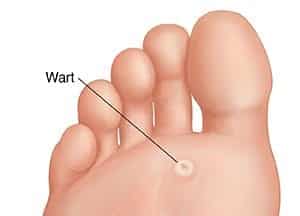What are plantar warts?
Warts are localised thickenings of the skin, and the term ‘plantar warts’ is used for those that occur on the plantar surface of the feet. They are also known as verrucae pedis.
Warts are localised thickenings of the skin, and the term ‘plantar warts’ is used for those that occur on the plantar surface of the feet. They are also known as verrucae pedis.

Warts are caused by an infection in the outer layer of the skin (epidermis) with the ‘human papilloma virus’ so-called HPV. There are many different strains of this virus triggering the skin to over-grow and thicken, leading to rapid, benign skin growth.
Plantar warts are caught by contact with infected skin scales. Many school kids who are enrolled in swimming classes get warts from the floors of public locker rooms or shower cubicles or areas around swimming pools. The virus enters the skin through tiny breaks in the skin surface.
If you ignore a severe plantar wart or a mosaic wart, the following could happen:
Depending on the size of the wart and how long the infection has been present, you may require several treatments. We recommend these chemicals be applied every 1-2 weeks until resolved. In some cases, we may encourage you to apply an over-the-counter treatment in addition to these chemical treatments throughout your treatment period.
Hyfrecator therapy is a highly effective, minimally invasive treatment for stubborn plantar warts. This procedure uses high-frequency electrical currents to precisely dehydrate and destroy wart tissue, minimizing damage to surrounding healthy skin.
Curettage is a surgical procedure where the area around the wart is numbed by a local anaesthetic. The podiatrist then removes the wart tissue to expose healthy skin. Phenol chemical is then used to burn the wart tissue and silver nitrate is used to stem the bleeding.
During the first few days post-surgery, you will need to stay off the foot as much as possible, as it will be tender with weight-bearing. Within 1-2 weeks most people are walking normally and pain is significantly reduced/resolved.

If you need an assessment or conservative treatment done, please book an appointment with Lewis.
If you have had previous wart surgery, or your wart has come back after conservative treatment, please book with Dr. Kim.